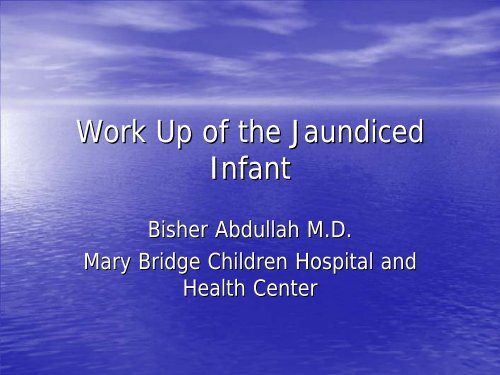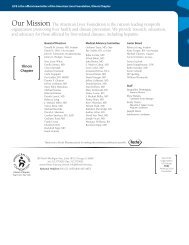Work Up of the Jaundiced Infant - American Liver Foundation
Work Up of the Jaundiced Infant - American Liver Foundation
Work Up of the Jaundiced Infant - American Liver Foundation
You also want an ePaper? Increase the reach of your titles
YUMPU automatically turns print PDFs into web optimized ePapers that Google loves.
Bilirubin Metabolism• Bilirubin is soluble in highly nonpolarsolvents in adipose tissue or <strong>the</strong> brain• Bilirubin is sensitive to light and convert tomore polar forms that can be excretedwithout conjugation• Toxicity <strong>of</strong> bilirubin to inhibit RNA andprotein syn<strong>the</strong>sis in <strong>the</strong> brain, inhibitsphosphorylation <strong>of</strong> cerebral lipids <strong>the</strong> finalpathway <strong>of</strong> neuronal signal transmission
Transport <strong>of</strong> Biliruibin• Plasma transport bilirubin ei<strong>the</strong>r bound toalbumin or free• Unbound bilirubin is fat soluble anddiffuses easily through cellular membranes• Affinity <strong>of</strong> bilirubin to albumin is reducedby drugs (Sulfa, anti inflammatory), PH orcontrast media
<strong>Up</strong>take <strong>of</strong> Bilirubin• Bilirubin transfer is bidirectional with freeexchange between plasma and intrahepatic• Bilirubin recognized by a hepatocyte plasmareceptor• Intracytoplasmic binding proteins (Y protein orligandin and Z protein) prevents <strong>the</strong> efflux <strong>of</strong>bilirubin back into plasma• Ligandin syn<strong>the</strong>sis is induced by Phenobarbital
Bilirubin Conjugation• Conjugation <strong>of</strong> bilirubin in microsomes <strong>of</strong>smooth endoplasmic reticulum• UDPG dehydrogenetion catalyzed by UDPG-dehydrogenase to glucuronic acid to bilirubinmono and diglucuronides• Glucuronyl transferase activity is present inmany tissues predominantly in liver increasesrapidly from birth to reach levels 1.5-2.5 times<strong>of</strong> those <strong>of</strong> adults at 2 weeks <strong>of</strong> age
Bilirubin Secretion• Transfer <strong>of</strong> conjugated bilirubin fromhepatic cells to <strong>the</strong> bile is energydependent (carrier mechanism)• Conjugated bilirubin is transformed intourobilinogen by bacteria in TI and colonwhich is limited in <strong>the</strong> first few days <strong>of</strong> life(incomplete colonization <strong>of</strong> intestines)
Acute UnconjugatedHyperbilirubinemia In <strong>the</strong>Newborn
Hemolytic Anemia• Blood group incompatibility (direct coombstest)• Hereditary hemolytic syndromes(hereditary spherocytosis, , G6PD orpyruvate kinase deficiencies)• Neonatal infections <strong>of</strong> bacterial (sepsis,UTI, etc..) or viral (dehydration, acidosis,drugs/antibiotics)
Physiologic Jaundice <strong>of</strong> <strong>the</strong>Newborn• Red blood cell breakdown• Serum factors (release <strong>of</strong> inhibitors, glucoseconcentration, etc..)• <strong>Up</strong>take across hepatic sinusoidal membrane• Binding (intracellular Y&Z proteins)• Conjugation (delayed maturation <strong>of</strong> UDPglucuronyl transferase activity, abnormal glucosehemeostasis/diabetic mo<strong>the</strong>rs)• Excretion (intracellular transport to bilecanaliculus)• Enterohepatic shunt (early feeding/colonozationcolonozation)
Physiologic Jaundice <strong>of</strong> <strong>the</strong>Newborn• Bilirubin values tend to reach in <strong>the</strong>normal full term infant by 4 th -6 th day <strong>of</strong> life(6-12) and higher levels in prematureinfant by 5th-6 th day <strong>of</strong> life (11-15)15)• Jaundice appears in term infant on 2d-3dday and last less than one week• Urine is pale• Stool has normal color
Criteria to Differentiate Physiologicfrom Pathologic Hyperbilirubinemia• Appearance <strong>of</strong> jaundice in <strong>the</strong> first 36 thhours <strong>of</strong> life with total hyperbilirubinemiaover 12 and rising• Rising conjugated hyperbilirubinemia• Anemia• Hepatosplenomegaly• Signs <strong>of</strong> infections or digestive problems
Fasting and UnconjugatedHyperbilirubinemia• Decreases intestinal motility (delayed bo<strong>the</strong>vacuation <strong>of</strong> meconium and development<strong>of</strong> bacterial flora)• Releasing glucagon and adrenaline whichactivate heme-oxygenase, increase serumfree fatty acids and interfere with bili-albbinding
Breast Milk Jaundice• Isomers <strong>of</strong> Pregnanediol inhibiting bilirubinconjugation has not been established• Increased free fatty acid and lipoproteinlipase (LPL) activity inhibiting bilirubinconjugation• Increased enterohepatic circulation andbeta-glucuronidaseactivity
Breast Milk Jaundice• Jaundice on <strong>the</strong> 5 th -6 th day <strong>of</strong> life andpersists as long as breast feeding iscontinued and decrease after 6-868 weeksand may last 3-434 months• Total unconjugated bilirubin rarely exeeds20• Kernicterus has not been observed
Chronic UnconjugatedHyperbilirubinemia In <strong>the</strong>Newborn
Conjugated HyperbilirubinemiaIn <strong>the</strong> Newborn
Extrahepatic Disorders• Extrahepatic biliary atresia (EHBA) 25-30%, bile duct stricture and choledochalcyst• Anomalies choledochopancreaticoductaljunction• Spontaneous perforation <strong>of</strong> BD• Inspissated bile• Mass (stone, tumor etc..)
Intrahepatic Disorders• Idiopathic neonatal hepatitis 15%• Intrahepatic cholestasis syndromes (Alagille(Alagille, , PFIC type1)20%• Alpha1 antitrypsin deficiency 7-10% 7• Bacterial sepsis 2%• CMV 3-5% 3• Rubella and herpes 1 %• Endocrine (hypothyrodisim(hypothyrodisim, panhypopittuitarism) ) 1 %• Metabolic (Galagtosemia(Galagtosemia, tyrosinemia, , or lipidmetabolism like Wolman, Gaucher or Nieman-Pick) 5%
Intrahepatic Disorders• Bile acids disorders• Toxic (TPN, fetal alcohol syndrome, drugs)• Genetic (Trisomies(18, 21 and 17)• Vascular (Budd-Chiarisyndrome, perinatalasphyxia, cardiac insufficiency )
Staged Evaluation <strong>of</strong> NeonatalCholestasis• Clinical evaluation (history, physical examand stool color)• Fractionated serum bilirubin• Tests for hepatocellular (ALT/AST) andbiliary disease (Alk(phos and GGT)• Tests for hepatic function (albumin, PT,serum glucose, amonia)
Staged Evaluation <strong>of</strong> NeonatalCholestasis• Exclude treatable and o<strong>the</strong>r disordersBacterial cultures, VDRL, viral serology likeTORCH/herpesA1AT level and phetotypeT4/TSHUrine metabolic screen ON feeds (urinereducing substance, urine bile and organicacids, serum amino acids and ferritin)Sweat CL test or genetic test for CF
Staged Evaluation <strong>of</strong> NeonatalCholestasis• Differentiate extrahepatic biliaryobstruction from intrahepatic disordersUltrasonography (hepatic texture, BD andGB)Hepatobiliary scintigraphy (HIDA scan) toevaluate poor uptake vs excreation<strong>Liver</strong> biopsy
Summary• Neonatal jaundice if largely benign it isimportant to timely evaluate and notdismiss <strong>the</strong> concern <strong>of</strong> jaundice• It is important to distinguish conjugatedfrom unconjugated hyperbilirubinemia• Always keep in mind <strong>the</strong> possibility <strong>of</strong>EHBA (Trio: T. bili/direct >5, GGT > 5folds and absence <strong>of</strong> GB on ultrasound)
THANK YOU



